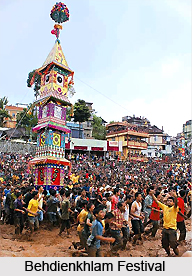 Culture of Jaintia Hills District is heavily influenced by the tribal traditions and customs prevalent in the region. The Jaintias inhabiting this district of Meghalaya are known for their rich art and culture. Culture of Jaintia Hills District includes indigenous hand woven traditional costumes that are worn during dances and festivals, and variety of cane, bamboo and wood crafts. Pestles and mortars for pounding rice, handles for knives, baskets, trays, mats, sunshades, rain shades, containers and other articles are made by the Jaintias.
Culture of Jaintia Hills District is heavily influenced by the tribal traditions and customs prevalent in the region. The Jaintias inhabiting this district of Meghalaya are known for their rich art and culture. Culture of Jaintia Hills District includes indigenous hand woven traditional costumes that are worn during dances and festivals, and variety of cane, bamboo and wood crafts. Pestles and mortars for pounding rice, handles for knives, baskets, trays, mats, sunshades, rain shades, containers and other articles are made by the Jaintias.
Jaintia music and dance is very rich and constitutes the unique culture of Jaintia Hills District. It is accompanied by different musical instruments such as bhuri (flute), bom (big drum), etc. Jaintias mainly celebrate two popular dance festivals namely Behdienkhlam festival and Laho Dance festival.
Behdienkhlam Festival is held every year during the rainy season of July or August. It is the most important and unique dance festival of the Jaintias. It is also considered as the most colorful religious festival. This festival is celebrated after the sowing period is over. A month-long preparation and the minor religious ceremonies involving sacrifices were being performed by the Lyngdoh precede the great event. A month before the festival, a sacrifice known as `Knia Khang` is performed to ward off all evils. The main purpose of this festival is to drive away all evils that plague the human life. At Jowai town, this festival can be seen being celebrated during the month of July. A day before the sacrifice, male members of the seven chosen localities of Jowai go to collect the plague driving trees. These big trees are not brought directly but are kept halfway for the night in a place called `Iawmusiang`. On the second day, these trees are erected at the centre of each locality. People dance on the streets with the accompaniment of drum beating and pipe playing. It is followed by immersion ceremony, preceded by religious rites and sacrifices at a sacred pool in the early hours of the morning. In the afternoon `datlawakor` is played between two teams from the upper and lower valleys of the Myntdu River. It is played with a wooden ball. The side which wins is believed to be blessed with a good harvest. People offer prayers for seeking the blessings of the Almighty for a good harvest.
Laho dance festival is another popular dance festival for entertainment of Jaintia people. Everyone with colourful costumes participate in this dance festival. There are several other dances performed in different places of Jaintia Hills District, but these two festivals are the most significant.



















